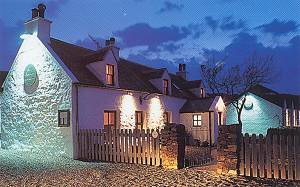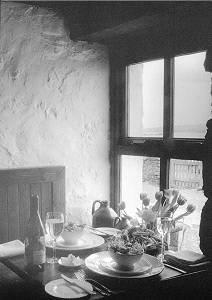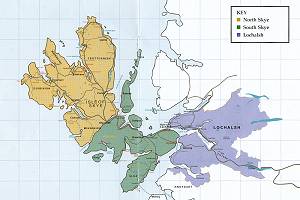Skye has just that: lots of sky, a vast canopy arching over the island which keeps the sun from penetrating. But when the greyness and mists lift, the island is revealed in all its pristine beauty: towering mountain peaks, wild moors, hard-blue lochs, rivers and seas, roaming herds of goats, sheep and cows.
Once the home of Gaelic-speaking chieftains and their battle- ready,
kilt-wearing, fiddle-playing clans, the island has become civilized over the centuries. Joined recently by an umbilical-cord bridge to the Scottish mainland, Skye retains only remnants of its once-unique way of life. Although a few natives still farm and fish, most make a living off the tourist trade, having converted their old crofts and castles into restaurants and b & b's.
Although Gaelic is taught in the schools and is seen on public signs,
English is the common tongue and many of the island's inhabitants are
sassenachs, outsiders who have come from England to retire or open small
businesses. Skye's beauty and tranquility (it has the one of the lowest
crime rates in the world) have also attracted numerous artists and craftsmen. These jewelers, candle- makers, potters, weavers, wood-carvers, printmakers, photographers and painters have brought fame and prosperity to the island, and drawn many thousands of visitors to their studios, homes and classrooms.
Without question, though, the island's main attractions are physical. Skye is an island for walking, climbing, bird-watching and biking. One is truly amazed by the grandeur of its mountains, the sweep of its moors and the fecundity of its seas, which contain everything from cod, mackerel and lobsters to dolphins, seals and whales.
While it's possible to swim in summer, that kind of pastime is, as one local said, " only for masochists." Most visitors restrict their nautical activities to sailing, fishing and kayaking.

Skye's abundant supply of seafood turns up on the tables of the island's numerous restaurants, one of the most notable of which is The Three Chimneys. Located in Colbost, in remote N.W. Skye, the restaurant
(with luxurious rooms attached) was founded 17 years ago by a British
couple who took over an old storm-battered general store and turned it
into a 4-star eatery with a worldwide following. Three Chimneys specializes in traditional dishes (fish, venison and fowl) spiced with local herbs, fruits and vegetables (many of which are organically grown). The owners' credo is "keep it fresh, keep it simple, keep it Scottish."
Other worthy restaurants include the Flodigarry Country House, Skeabost House Hotel and Kinloch Lodge, once the ancestral home of Lord and Lady MacDonald. Skye can also boast of its own whiskey distillery (Talisker) and a brewery.

The island's main town of Portree, named after King James the Fifth (who stopped here during his tour of the Hebrides), has shopping, bookstores, fish & chip shops and a cultural center. It's also where the bus from Glasgow deposits visitors. IThough it's possible to fly to the island via Inverness, most tourists arrive by car (the ferry from the mainland costs $15, plus $2.50 per person; while the bridge toll is a flat $5).
Whatever one's means of transport, the trip to Skye is well worth it. As Samuel Johnson, one of the island's first visitors, said back in 1773, "The joyous social manners of the inhabitants are praiseworthy--especially when they talk in their own ancient language, with fluent vivacity, and sing many Erse (Gaelic) songs."
For further information, contact: Tourist Information Centre, Portree,
Bayfield House, Bayfield Rd., Portree, Island of Skye, Scotland 1V 51
QEL. Tel 014-786-12137. Fax 612-141
Shilasdair, The Skye Yarn Co., Waternish, Isle of Skye, IV 55 8GL. Tel.
01470 592 297 www.shilasdair-yarns.co.uk
The Three Chimneys, Colbost, Dunvegan, Isle of Skye IV 55 8LT, Tel.
0140-511-258. E-mail: eatandstay@threechimneys.co.uk
